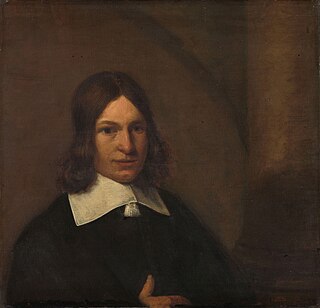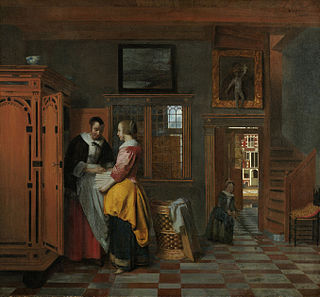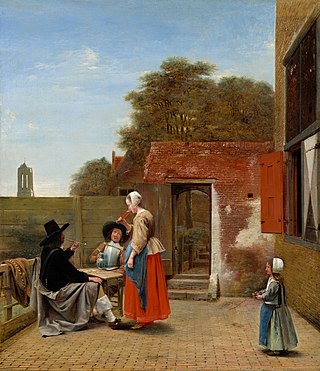
Pieter Hendricksz. de Hooch, was a Dutch Golden Age painter famous for his genre works of quiet domestic scenes with an open doorway. He was a contemporary, in the Delft Guild of St. Luke, of Jan Vermeer with whom his work shares themes and style. De Hooch was first recorded in Delft on 5 August 1652, when he and another painter, Hendrick van der Burgh witnessed the signing of a will. He was active in 1683, but his date of death is unknown.

Cornelis Hofstede de Groot, was a Dutch art collector, art historian and museum curator.

Jacob Vrel was a Dutch, Flemish, or Westphalian painter of interiors and urban street scenes during the Dutch Golden Age (1588–1672). He was likely most active from 1654 to 1662.

A Boy Bringing Bread is an oil-on-canvas painting by the Dutch painter Pieter de Hooch. It is an example of Dutch Golden Age painting and is part of The Wallace Collection, on display at East Galleries II in London. The painting was likely painted soon after De Hooch's arrival in Amsterdam from Delft in the early 1660s.

A Woman with a Child in a Pantry is an oil-on-canvas painting by the Dutch Golden Age painter Pieter de Hooch, created c. 1658. It is part of the collection of the Rijksmuseum, in Amsterdam.

Two Women Beside a Linen Chest, with a Child is an oil-on-canvas painting by the Dutch painter Pieter de Hooch, created in 1663. It is part of the collection of the Amsterdam Museum, on loan to the Rijksmuseum.

Mother with a Child and a Chambermaid (1665–1668) is an oil-on-canvas painting by the Dutch painter Pieter de Hooch. It is an example of Dutch Golden Age painting and is part of the collection of the Amsterdam Museum.

A Mother's Duty (1658–1660) is an oil-on-canvas Dutch Golden Age painting by the Dutch painter Pieter de Hooch. It is part of the collection of the Amsterdam Museum, on loan to the Rijksmuseum.

A Man Smoking and a Woman Drinking in a Courtyard (1658–1660) is an oil-on-canvas painting by the Dutch painter Pieter de Hooch. It is an example of Dutch Golden Age painting and is part of the collection of the Mauritshuis, in The Hague, Netherlands.

A Dutch Courtyard (1658–1660) is an oil-on-canvas painting by the Dutch Golden Age painter Pieter de Hooch. The original resides in the collection of the National Gallery of Art in Washington, D.C. A later, altered replica also exists, part of the collection of the Mauritshuis Museum in The Hague.

Lady and Her Cook is an oil-on-canvas painting by the Dutch painter Pieter de Hooch, created c. 1660. It is part of the collection of the Hermitage Museum, in St. Petersburg.

The Maidservant is an oil-on-panel painting by the Dutch painter Pieter de Hooch. It is held in the Metropolitan Museum of Art, in New York.

Company in a Courtyard Behind a House (1663–1665) is an oil-on-canvas painting by the Dutch painter Pieter de Hooch. It is an example of Dutch Golden Age painting and is part of the collection of the Amsterdam Museum, on loan to the Rijksmuseum.

A Woman Drinking with Two Men is a 1658 painting by Pieter de Hooch, an example of Dutch Golden Age painting and is part of the collection of the National Gallery, London.

Interior with a Young Couple and a Dog (1662) is an oil-on-panel painting by the Dutch painter Pieter de Hooch. It is an example of Dutch Golden Age painting and is now in the Metropolitan Museum of Art in New York City.

Young Woman with a Letter and a Messenger in an Interior (1670) is an oil-on-canvas painting by the Dutch painter Pieter de Hooch. It is part of the collection of the Rijksmuseum, in Amsterdam.

Musical Party in a Hall is an oil-on-canvas painting by the Dutch painter Pieter de Hooch. It is an example of Dutch Golden Age painting and is now in the Museum der bildenden Künste, in Leipzig, Germany.

A Man with Dead Birds, and Other Figures, in a Stable is an oil-on-oak painting by the Dutch painter Pieter de Hooch. It is an example of Dutch Golden Age painting and is now in the National Gallery, London

A Woman Preparing Bread and Butter for a Boy (1660–1663) is an oil-on-canvas painting by the Dutch painter Pieter de Hooch. It is an example of Dutch Golden Age painting and is part of the collection of the Getty Center, in Los Angeles, California.



















